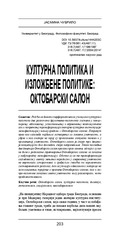Kulturna politika i izložbene politike - Oktobarski salon
Policy of culture and policy of display: The October salon
| dc.creator | Čubrilo, Jasmina | |
| dc.date.accessioned | 2021-10-12T12:02:56Z | |
| dc.date.available | 2021-10-12T12:02:56Z | |
| dc.date.issued | 2014 | |
| dc.identifier.issn | 0023-5164 | |
| dc.identifier.uri | http://reff.f.bg.ac.rs/handle/123456789/1900 | |
| dc.description.abstract | Rad će se baviti performativnim učincima kulturnih politika dva različita društveno- politička sistema u koncipiranju, oblikovanju, uspostavljanju i održavanju kontinuiteta ali i pokretanju transformacija značajne kulturne institucije/ manifestacije u našoj sredini - Oktobarskog salona. Pokrenut prvo kao izložba najboljih ostvarenja iz likovne umetnosti, a ubrzo i kao smotra na kojoj su prikazivani aktuelni tokovi i u primenjenoj umetnosti, Oktobarski salon je skoro tri decenije koncepcijski bio dosledan, skoro nepromenljiv. Tokom poslednje dve decenije Oktobarski salon prolazi kroz izmene, od kojih su neke bile i radikalne (pretvaranje Oktobarskog salona iz lokalne u međunarodnu manifestaciju). Obično su se te transformacije sagledavale u svetlu menjanja paradigmi u savremenoj umetnosti po vertikali (staro- novo) i (ređe)/ ili (češće) po horizontali (istovremenost razlika), dok se uticaji ideoloških matrica na osmišljavanje, trajanje i promene Oktobarskog salona, kao i mikro- politike lokalnog sveta umetnosti nisu razmatrali, niti problematizovali. | sr |
| dc.description.abstract | This paper is about perfomative effects of cultural policies in two socio-political systems differing in concept, forms, establishment and maintenance of continuity but also in initiating transformations of the nationally significant cultural institution/event - the October Salon. Initially started as an exhibition of the best art accomplishments and soon a place to display modern trends in applied arts, the October Salon has been conceptually consistent, and almost resistant to change, for almost three decades. For the last two decades, however, the October Salon has been embracing changes, some of which have even been radical (like switching from national to international). Usually, these transformations were observed as a change of paradigms in modern art: mostly vertical (old/new) and rarely or quite frequently horisontal (contemporary differences).The impacts of ideological matrices on the deliberation, continuation and alternations of the October Salon and the micro-politics of the local art community were not considered or analysed. | en |
| dc.publisher | Zavod za proučavanje kulturnog razvitka, Beograd | |
| dc.relation | info:eu-repo/grantAgreement/MESTD/Basic Research (BR or ON)/177013/RS// | |
| dc.rights | openAccess | |
| dc.source | Kultura | |
| dc.subject | socijalizam | sr |
| dc.subject | Oktobarski salon | sr |
| dc.subject | neoliberalizam | sr |
| dc.subject | kulturna politika | sr |
| dc.subject | disenzus | sr |
| dc.subject | antagonizam | sr |
| dc.subject | socialism | en |
| dc.subject | October Salon | en |
| dc.subject | neoliberalism | en |
| dc.subject | dicensus | en |
| dc.subject | cultural policy | en |
| dc.subject | antagonism | en |
| dc.title | Kulturna politika i izložbene politike - Oktobarski salon | sr |
| dc.title | Policy of culture and policy of display: The October salon | en |
| dc.type | article | |
| dc.rights.license | ARR | |
| dc.citation.epage | 230 | |
| dc.citation.issue | 144 | |
| dc.citation.other | (144): 203-230 | |
| dc.citation.rank | M51 | |
| dc.citation.spage | 203 | |
| dc.identifier.doi | 10.5937/kultura1444203c | |
| dc.identifier.fulltext | http://reff.f.bg.ac.rs/bitstream/id/737/1897.pdf | |
| dc.type.version | publishedVersion |

